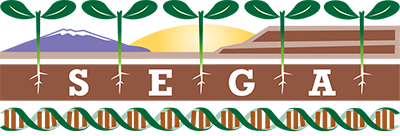You are here
San Diego students plant trees at Little Colorado River
Thirty high school students from San Diego’s High Tech High School traveled to Flagstaff for first-hand field experience at a Pulliam Charitable Trust/SEGA research site. The students planted 850 cottonwood saplings during their two-day stay at a new experimental garden and restoration site along the Little Colorado River.
The restoration work and research is led by SEGA Co-PI Professor Tom Whitham, who received the grant from the Nina Mason Pulliam Charitable Trust to restore a portion of the Little Colorado River that had been degraded by the invasion of nonnative tamarisk trees.
“Our goal is not to restore for past or even current conditions, but to pre-store to forecasted future conditions,” said Whitham. “Historically, there has been a very long lag time between basic research in a greenhouse and implementation in the field, but given the pace of change, we can no longer afford to do it that way.” And Whitham is keen to acknowledge the significant help provided by Paul Capps at NAU Campus Services and Activities for the loan of a tractor for a period of time. The team had been unable to rent such a machine and so this interdepartmental contribution has proved hugely helpful as an essential tool in the restoration work.
Part of the site is also a core SEGA site, currently being instrumented with a full NOAA-grade weather station, soil moisture and temperature probes, as well as an irrigation system, all located on land managed by Babbitt Ranches (http://www.babbittranches.com/) – who have been a supportive SEGA collaborator. Two other SEGA sites (Black Point and Blue Chute) are also on Babbitt Ranch land.
During their visit, the students - in addition to planting trees, learned about genetics, plant physiology, fungal ecology and native species from researchers. Collaborators included the U.S. Geological Survey, local nonprofits, which oversees the restoration site.
NAU doctoral student Lisa Markovchick, a recipient of the Presidential Scholarship, designed and organized the project.“Working with the students and seeing the video they created …
… reminded me of the amazing power of science to change the way we understand the world around us,” Markovchick said. “The students not only had the opportunity to participate in real-world research but also they got to experience the joys of being outdoors in northern Arizona and learning about this place and its people. The students said the trip was the best experience they’ve ever had.”
High Tech High School is a public charter school required to match its enrollment to the ethnic and socioeconomic diversity of San Diego County, one of the most diverse counties in the United States. The project was designed to not only expose the students to cutting-edge research and the possibility of a STEM career, but also teach them about northern Arizona’s local history, people and ways of life.
[Original article written by Lara Schmit for NAU News]
Theme by Danetsoft and Danang Probo Sayekti inspired by Maksimer
